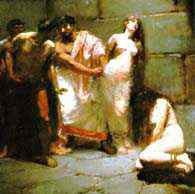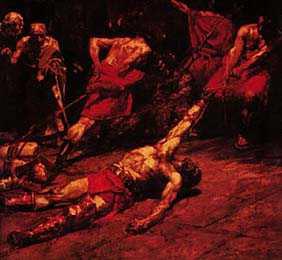| The basis of our group web site is to inform our viewers of the Filipino cultures and what surrounds their heritage, to acquaint the onlooker on Filipinos' art history and to what it is now in the present. The viewer will see Filipino artists and their works. From architectural work, to artifacts such as indigenous weapons, pottery, and sculptures. The viewer will be introduced to the historical foundation of the web site, to Muslim culture, Spanish rule, and Chinese influence. The Muslim culture influenced the early Philippines with their knife sculptures, their garments, and Muslim mask paintings that were use in Muslim dances to honor their Gods. The Spanish reign influenced Filipinos in many ways, from their Roman Catholic religion and Spanish culture. The Philippine colonial period extended from 1521 to 1956 (377 years Spanish and 48
years American). The immigration period, on the other hand, started in the early 1900s up to the present. These 'national experiences' figure significantly in the stock inventory of remembered images that affect the Filipino- American society. Due to the impact of Spanish rule, Filipino art was greatly affected by their artifacts of wooden sculptures of religious icons, Spanish architecture, and traditional garments.
The later years of Chinese influence, due to migration of Chinese to the Philippines, has formed a Buddhist culture that also affected Filipino art. All these influrnces from different religions, and cultures have established Filipinos' own, authentic way of thinking that has composed a new age of Filipino art.
The web site will be divide by Culture and Era. Form the different cultures will be paintings, religious icons, sculptures, sculptures in the Philippines had a long and controversial history under the influences of the Catholic Church, Spain and the United States. Religion and revolution produced a great many works in the classical and realist idioms with sculptors like Bonifacio Arevalo, Marcelo Nepomuceno, Graciano Nepomuceno and, later, the classically trained Guillermo Tolentino, at the forefront. Contemporary Philippine sculpture is rich in forms, media, and concepts and reflects many of the continuing concerns of Filipino society. (Alice Guillermo. Spring issue (1995) of Asia-Pacific Sculpture News.) The site will show Early Pottery of Artistic Filipinos, a detail of Juan Luna's Spoliarium, a detail of Felix Resurreccion Hidalgo's Virgenes Cristianas Expuestas al Populacho.
These two paintings above won the gold and silver medals at the 1884 Madrid Exposition. The site will also show Sining Filipino Art Exhibit - an art exhibit which features the works of 13 Filipino artists. By clicking to these images you can find the history, where was it founded, what was it use for (in some cases), what cultural influence, and also the background of the artist (if found). My great concern for our web site is that it will be informative and detailed, but also that viewers will enjoy. |

 |

